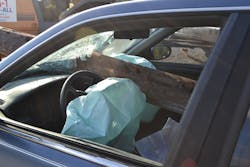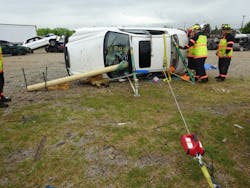University of Extrication: Stabilizing an Impaled Vehicle
Topic: Impaled-vehicle stabilization training
Objective: Develop and practice procedures for stabilizing a vehicle that was impaled by an object
Task: The rescue team shall develop protocols for vehicle stabilization when a pole, pipe or the like pierced a vehicle and occupants are trapped
In the realm of stabilization training, it’s worthwhile to create various vehicle scenarios. For example, when a pole, pipe, street signpost or highway guard rail, or what we will call an impaled object, pierces/runs through a vehicle and an occupant(s) is trapped, a unique action might be necessitated.
Those who are responsible for vehicle rescue training easily will be able to duplicate the scenarios that are presented below so as to challenge their personnel with hands-on skills training.
Editor’s note: The overall strategy for this training is vehicle stabilization. There are multiple tactics to employ to accomplish stabilization, and they make up the heart of the hands-on skills.Beyond the basics
For rescuers who are assigned to a crash scene, they typically must take action to make the situation safe for rescuers and vehicle occupants to be in, on and around any vehicle or object that’s involved in the incident: The scene is stabilized. However, when a member of a rescue team is asked what’s the most frequent task that he/she accomplishes at a crash scene, the reply typically is “a door job.”
Each rescue agency’s vehicle stabilization protocol should be to stabilize every vehicle, every time. That said, we must recognize that not all stabilization challenges are the same, and they might not involve the same amount of effort or equipment. Yes, a passenger vehicle that sits on four inflated tires on a level surface can be quickly and effectively stabilized by one or two rescuers who use only a few tools or pieces of equipment. The training scenarios that are addressed here go beyond this basic stabilization. Vehicle stabilization tactics to consider when an object impaled a vehicle should include three distinct efforts: work to stabilize the vehicle(s) that’s involved; secure or stabilize the object that impaled the vehicle; and join, or marry, the vehicle(s) and the object together.
With a pole or the like stuck into and/or through the occupant area of the vehicle, it’s possible that the object might be in close proximity to a trapped occupant. After stabilization is complete, the possibility of a unique tactic to remove a section or portion of the object inside of the vehicle to free trapped occupants always should be considered.
Two scenarios
For the two training scenarios that are presented here, we encounter a wooden power line pole and a hollow steel pipe, respectively.
In the first operations-level training scenario, the acquired vehicle rests on its four wheels on a level surface. The wooden pole runs horizontally through the windshield, through the interior of the vehicle and out of the rear window. It rests on the hood and on the trunk lid of the vehicle. Our trapped occupant (a smokehouse dummy) is seated and belted in the driver’s seat.
As it is with all of our training arrangements, an initial strategy is to stabilize the scene—the vehicle and the pole in this case. When confronted with this type of vehicle-impaled situation, rescuers have three stabilization tactics available to them. They must stabilize the vehicle in a normal fashion: typically, chock, block and blow/deflate. Simultaneous with this, the unsupported pole must be dealt with, then it and the vehicle must be secured together to finish the job.
Realizing that marrying the pole to the vehicle might be a good solution to both of these last two objectives, a crew can utilize 2-inch-wide ratchet straps, wedges and cribbing, to, essentially, bind the pole to the vehicle, which, in turn, secures the pole firmly in place.
In our second, more challenging and complex operations-level training, the impaled vehicle is positioned side-resting on the driver’s side. The heavy steel pipe typically would settle to a low position, which puts it very close to the trapped driver. Interior rescuers need to be alert to this close patient proximity.The same tactical objectives—stabilize the vehicle, stabilize or secure the pipe and marry the two together—are in play. Although a common solution for side-resting-vehicle stabilization is to use cribbing and struts, a variation is the side-resting, side-obstructed tactic.
In this scenario, the undercarriage, or bottom side, of the vehicle is obstructed. This more challenging scenario requires crews to use cribbing, two struts, rescue chain and a portable winch as a pulling tool. (The pulling-type load can be created with a ratchet strap, a come-along, a Griphoist or a winch, placed on one side of the vehicle to gently pull the vehicle or to hold it against the stabilizing struts.)
When the side-obstructed stabilization protocol is put in place, it keeps one side of the vehicle or the other free of the congestion of any stabilization equipment and rescuers. This provides clear access on one side for EMS and extrication work.
Push them
Whether dealing with a vehicle that rests on its wheels or on its side or roof, stabilizing the object that impales the vehicle can be completed by working with the object directly or by marrying it to the vehicle. Furthermore, adding these challenges to a training session better prepares crews for more complex stabilization situations of any sort, period.
Impaled Object Tactics
- Stabilize vehicle(s)
- Stabilize impaling object
- Marry object and vehicle(s) together
- Monitor stability throughout incident
About the Author
Ron Moore
RON MOORE, who is a Firehouse contributing editor, recently retired as a division chief with the McKinney, TX, Fire Department and now serves with Prosper, TX, Fire Rescue. He self-published the Vehicle Rescue 1-2-3 training manual and serves as the forum moderator for the extrication section of Firehouse.com . Moore can be contacted directly at [email protected].



